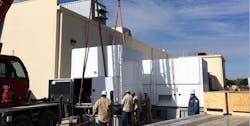Texas Microgrid has closed on financing that could serve as a model for other microgrid projects in Texas’ wholesale power market.
The financing supports the construction of a portfolio of natural gas-fired microgrids in the Electric Reliability Council of Texas (ERCOT) territory that, when fully built out, will have 232 MW of capacity.
Texas Microgrid is a joint venture indirectly owned by investors managed by Basalt Infrastructure Partners and Enchanted Rock Holdings, which will serve as the construction, operations and asset manager for the microgrid projects.
Backbone of Texas Microgrid
The common theme of the microgrid projects that will be built under the financing structure is that they will be used to provide emergency backup power for commercial and industrial customers (C&I), particularly in the cold storage, food and beverage, manufacturing and healthcare sectors.
Those sectors are the backbone of Enchanted Rock and Texas Microgrid’s business plan. In May, for instance, Enchanted Rock announced a deal to supply Citizens Medical Center with a gas-fired microgrid that will supply the healthcare facility with electrical power during a utility outage.
In 2016, Texas Microgrid signed two deals to provide backup power to retail stores. In one, Texas Microgrid agreed to provide microgrid reliability services to 10 stores owned by Buc-ee’s, which runs a chain of convenience stores, mostly in Texas.
During an outage, the microgrid generators would provide backup power for the Buc-ee’s stores. In the other, Texas Microgrid is installing gas-fired microgrids at 45 grocery stores run by Texas-based H-E-B, one of the nation’s largest grocery chains.
Financing covers 150 sites
The just closed financing covers planned backup microgrids at 150 sites. Typically, each installation is for a microgrid with a capacity of roughly 1 MW. The $50 million loan was structured as a seven-year senior term note. ING Capital is serving as administrative agent for the credit facilities, and The Bank of New York Mellon is serving as collateral agent and the depository bank.
The names remain confidential of the microgrid customers, but they tend to be in “an industry where having backup power is essential to the integrity to the underlying business,” said Ron Erlichman, a partner at Bracewell, who worked on the financing deal.
If the customers were to install a microgrid themselves, “it would be an extraordinary capital investment.” But using Texas Microgrid’s On Demand Electric Reliability business model provides customers with a relatively low cost way to achieve reliability. “It is like an insurance policy for loss of power,” Erlichman said.
The contracts between Texas Microgrid and its customers involve some upfront costs, but income from the microgrid enables Texas Microgrid to keep costs relatively low while providing a revenue stream to help secure the financing.
Microgrid financiers sometimes find it difficult to identify revenue streams available to pay down the debt incurred, particularly if there is no power purchase agreement with a creditworthy partner, such as a utility. That is particularly true for microgrids designed to provide backup power or emergency services during an electrical outage. There is no surety in the revenue stream because there is no telling when an emergency or an outage might occur.
There is value in the generators that go into the microgrid installations, and they can be used as collateral for the loan. But a generator alone is not sufficient to underpin a loan, Erlichman said. So, the deal was structured to also include the contractual agreements between Texas Microgrid and its customers.
If a customer needs to call on the microgrid during an emergency, they pay Texas Microgrid for the power, providing a source of revenue to the project and its lenders.
Key is 4CP in ERCOT
The key to the financing, however, is a unique feature of ERCOT’s wholesale power market. Under ERCOT’s Four Coincident Peak (4CP) program, customers who are able to reduce their electric usage during certain peak months receive a credit that can be used to lower their future demand charges.
“It is similar to peak shaving, but it is offsetting ERCOT’s demand charge,” Erlichman explained. The microgrid facility can be used to reduce peak usage, and the resulting credits can be turned into a revenue stream available to Texas Microgrid and its lenders.
The microgrid facility also has the potential to offer demand response services to ERCOT’s ancillary services market, but “lenders are not quite comfortable with that yet” as a bankable source of revenue, Erlichman said.
There is also the potential to sell energy from the microgrid into ERCOT’s wholesale power market, but from the lender’s perspective that possibility is lower down in the stream of potential revenue sources.
Texas Microgrids’ bankers and advisers drew on elements of project financing structures that are widely used in the power industry, but the key was to customized the structure to match the characteristics of the microgrid projects and the Texas market in which they are being deployed.
“This project and the financing structure is a first of its kind and could set the stage for the financing of future microgrid projects in the ERCOT market,” Erlichman said.
Track news about microgrid financing. Subscribe to the free Microgrid Knowledge newsletter.







